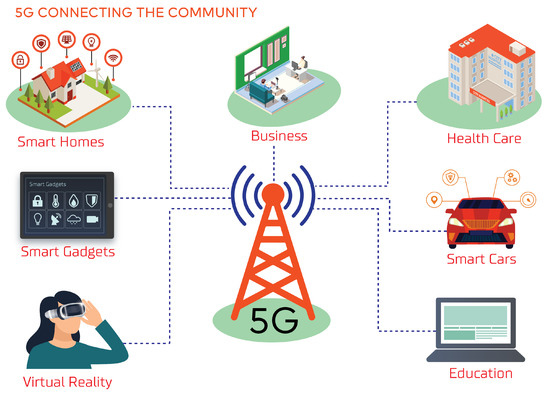You're using an outdated browser. Please upgrade to a modern browser for the best experience.
Please note this is a comparison between Version 1 by Ali Sufyan and Version 2 by Rita Xu.
The histrionic growth of mobile subscribers, disruptive ecosystems such as IoT-based applications, and astounding channel capacity requirements to connect trillions of devices are massive challenges of the earlier mobile generations, 5G turned up the key solution.
- mMIMO
- 5G
- augmented reality
- virtual reality
1. Introduction
The deployment of fourth-generation long-term evolution network (4G-LTE), and its extension long-term evolution- Advanced (LTE-A) in various countries have not only accomplished the International Mobile Telecommunications Advanced (IMT-A) constraint by utilizing IP envisioned for all services but also maintained up and around 1 Gb/s less mobility and 100 Mb/s data rate for large mobility. The histrionic growth of more mobile data subscribers in recent years is the result of people’s craving for faster internet while on the go. The Wireless World Research Forum (WWRF) forecaste around 7 trillion mobile products will provide 7 billion individuals in 2017; which is about 1000 times the world’s population [1]. While as per Ericsson’s technical mobility report published in 2017, almost 29 billion devices are forecast by 2020 including 18 billion IoT related [2]. Furthermore, Rangan et al. [3] predicted 50 billion devices by 2020 and will keep up growing exponentially by around 5 zetta-bytes per month in 2030 [4]. IoT applications demand such as smart homes/cities/grids etc., sensors networks, explosive big data, and wearable artificial intelligent devices are increasing exponentially [5][6][5,6]. That has raised substantial attention to form new mobile standards in the telecommunication market.
Against these requirements, the massive data; peta-bytes (10,005 bytes), internet speed in Giga-bits per second (GB/s), and connection to trillions of devices definitely need next-generation wireless communication systems. To encounter these huge challenges, design and establish new standards for the next 5G communication, the academia, the standardization agencies, and the telecom industry are working in accordance [7][8][7,8]. Also, drastic enhancements and new innovations are essential to be made during network design both in physical and upper layers [9]. Emerging technologies such as disruptive ecosystems like IoT named as connected community and machine-to-machine (M2K) communications are also in consideration to be an important part and known as tactile Internet, a newly invented term [10]. METIS [11] and 5GNOW [12] are two main European ventures to address 5G networks. To reduce the firm orthogonality and synchronization criteria in present systems, particularly, 5GNOW explored new physical layer patterns by using non-orthogonal waveforms.
The key objective of the 5G network is not only to maintain a 1000-fold capacity gain and 10 Giga Bits per second delivered to a single user but also to assure quality-of-service, higher spectral efficiency (SE), the ultra-reliable and improved battery life of devices, less expensive and massive machine-type communication as dissipated in Figure 1. Only 5G networks can tackle these challenges and it will contribute a true universal boundless mobile experience through upgraded terminals, low latency, and ultra-reliable connectivity. The major challenge of the 5G network is tremendous mobile traffic demand.

Figure 1. The prime objective of 5G.
This would certainly place a huge amount of traffic load at the edge and a huge amount of data will be processed in the cloud and consume a large number of resources which will not only affect the inadequate capacity of traditional cellular cells but also interrupt the admission and service of other subscribers. Another challenge for organizations is to process multiple repositories from multiple users using multiple applications in multiple environments simultaneously, producing a large amount of digital garbage and useless information. For example, data received from smart homes and health care are processed at the edge [13], processed at the fog to produce helpful information [14], and visualized in subscriber devices. Therefore, the edge, the fog, the cloud, and even the subscriber devices play an important role in the life process of the management of this data (i.e., smart cars, virtual reality, and health care). Therefore, it is a need to design, develop, and implement architectural models to produce on-demand and edge-fog-cloud processing systems to continuously handle big data.
The key problem with the ongoing development of mobile wireless systems is that it is thoroughly dependent upon network densifying to the cells or enhancing spectrum to attain the required throughput. The saturation point of these rare resources is almost reached. Moreover, cell densification and bandwidth increase also increases network latency and pay the cost of expensive hardware. Therefore, the throughput can effectively be increased by an untouched factor of SE without increasing cell densification and bandwidth to meet the current needs of wireless networks. Considering all these challenges, it also makes compulsory new means of channel capacity enhancements and SE techniques. Massive MIMO is an important part of the 5G key enabling technologies and is considered to be the solution to the above-discussed challenges.
The data rate that can be communicated by a certain bandwidth in a particular communication network is referred to as SE, measured in bits/Sec/HZ. Spectrum efficiency, spectral efficiency, or bandwidth efficiency is a technical quantity described as the data rate that can be communicated over a specified bandwidth and used to measure a frequency band. It can be enhanced through increasing modulation order.
2. 5G Evolution
The 5G cellular system offers an extremely expandable and flexible network scheme to connect everything and everybody, everywhere. Several industries, e.g., DOCOMO, Huawei, ZTE, Ericsson, Qualcomm, Samsung, Vodafone, and Nokia Siemens Network have paid countless enthusiasm to develop 5G networks so far. Broadly, 5G is categorized into three domains:-
Ultra-Reliable Low Latency Communication (URLLC): fast and highly reliable with 100% coverage and uptime, applications to unmanned vehicles and smart factories
-
enhanced Mobile Broadband (eMBB): whose goal to provide large data applications, massive device and user capacity for wireless broadband services

Figure 2. 5G, connecting the community.
